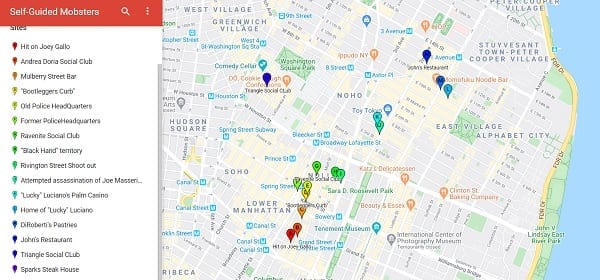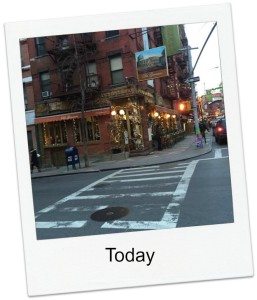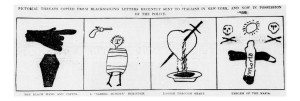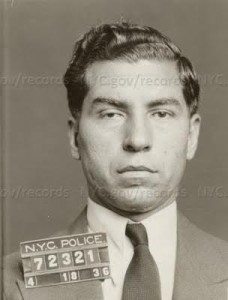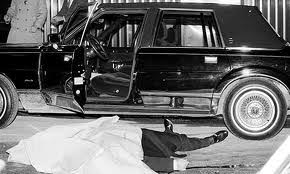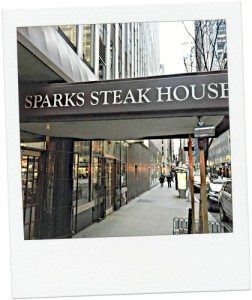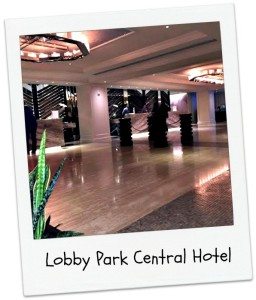This New York mafia tour focuses on the 5 mafia crime families of New York City and takes you through the heart of Little Italy to the East Village and includes three stops in Midtown.
You will go to the former headquarters of the biggest crime families to the exact spot where men were shot down in cold blood.
THE NEW YORK GANGSTER TOUR
Be sure to check out our full list of self-guided tours of NYC.
Groupon has many guided mafia tours at concessionary prices.
Fans of the Sopranos might want to check out the On Location Tours Sopranos sites bus tour.
If you are considering purchasing a tourist concession pass while in NYC, then keep in mind that the Sopranos Tour is included for free with most.
This is an interactive map. Simply move around with your mouse.
You can also click here for a printable PDF of this tour.
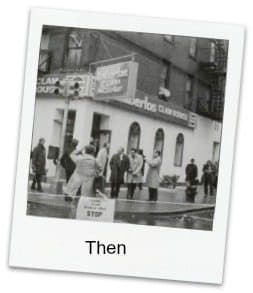
(A) Hit on Joey Gallo
129 Mulberry St.
It was here, on April 7, 1972, that ‘Crazy’ Joey Gallo was shot dead in plain sight.
At the time, the restaurant was Umberto’s Clam House, now located around the corner.
Gallo was out celebrating his 43rd birthday with his new bride, her daughter, and a small group of family and friends.
At 5:10 am, four members of the Columbo crime family came in the side door where Gallo’s group was seated.
One of the assassins shot Gallo three times at close range.
Somehow, Gallo managed to get up and stagger out the door onto Hester Street. He got as far as his Cadillac, where he collapsed and died in a pool of blood.
Why did “Crazy’ Joey Gallo have to go?
Earlier that week, Gallo had ‘sponsored’ a break-in at Ferrara’s Pastries nearby on Grand Street.
The robbers grabbed $55,000 and “Crazy” Joe had signaled to the Five Families that, after a 9-year prison stint, he was back in town and someone to be reckoned with.
But the Columbo family had an association with the Ferrara business and they didn’t take the Gallo robbery lightly.
They took revenge when they gunned Gallo down. Later that week, the two robbers were also assassinated.
(B) Former Andrea Doria Social Club
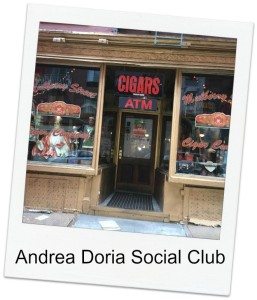
140 Mulberry St.
On May 20th, 1985, John Gotti, the Don and (boss) of the Gambino crime family, stopped by this cigar shop for one last smoke before turning himself in to the Feds that afternoon.
Gotti is one of the most infamous mobsters, whose ability to dodge criminal charges, including three high-profile trials that ended with an acquittal, earned him the name of “The Teflon Don” – nothing would stick to him.
It wasn’t until 1992 that Gotti was convicted of five murders, conspiracy to commit murder, racketeering, obstruction of justice, illegal gambling, extortion, tax evasion, and loansharking.
He was sentenced to life in prison without parole. He served only 10 years of that sentence because he died in prison of throat cancer in 2002.
Salvatore Briguglio, a New Jersey Teamsters official is gunned down at this social club in 1978.
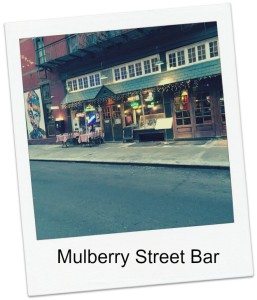
(C) Mulberry Street Bar
176 Mulberry St.
Take a peek into the windows of the café style bar that opened in 1908 as Mare Chiaro.
It may look familiar to you if you are a Sopranos TV series fan.
The red-and-white tiled back room was the scene of dozens of Soprano ‘family’ meetings.
It was also the setting for the scene where Johnny Depp meets Al Pacino in Donny Brasco and has been featured in The Pope of Greenwich Village, The Godfather III, and Law & Order.
(D) ‘Bootleggers Corner’
corner of Kenmare and Mulberry Street
From 1920 to 1933, America was in a period of alcohol lockdown called Prohibition.
The government had made it illegal to sell, produce, import, or transport alcohol, but plenty of people worked their way around it.
This corner was unofficially known as the "Curb Exchange," a market that sold alcohol illegally.
Some of the most famous original gangsters made their fortune and rose to power during Prohibition, guys like Joey "the Boss" Masseria, ‘Lucky’ Luciano, Frank Costello, Vito Genovese, and Thomas Lucchese, all of whom are depicted in the hit TV series Boardwalk Empire.
(F) Former Police Headquarters
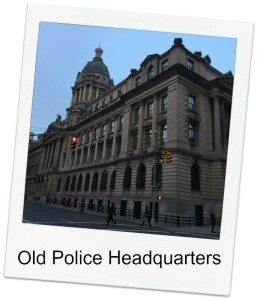
240 Centre St.
From 1909 to 1973, this formidable building served as the New York City Police headquarters.
Built in what was then Little Italy, the size and design of the building were meant to intimidate the local criminals.
Ironically, according to popular folklore, during Prohibition, some police officers built a tunnel under Centre Street that led to nearby O’Neill’s tavern where they could grab an illegal drink!
In 1973, the New York Police Department relocated its headquarters to 1 Police Plaza in Lower Manhattan.

(E) Old Police Headquarters Precinct
300 Mulberry St.
From 1862-1909, before the massive HQ on Centre Street was built, this non-descript five-story apartment building was “America’s Scotland Yard” as the New York Times referred to it back then.
Criminal and gang activity was rampant during these years and the police force dedicated many resources to curbing the violence throughout the city.
One whole room in this building, called the “Rogue’s Gallery” was dedicated to a collection of 7,000 photographs of the city’s criminals to be used when hunting down suspects.
(G) The Ravenite Social Club
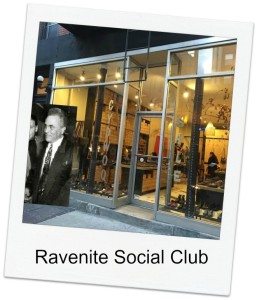
247 Mulberry St.
As far back as 1926, this club had been the site of mob meetings. In the 1970s and 1980s, the club was used as the HQ for the Gambino family.
John Gotti used an apartment on the 3rd floor to meet with members of the family.
Starting in 1990, the FBI was able to successfully install wiretaps inside the apartment and used the recordings to nab Gotti as well as Gambino family underboss Sammy ‘the Bull’ Gravano.
Gravano turned on Gotti before trial and become an informer in exchange for getting a “Don’t go to jail” card for the 19 murders he had committed.
Gravano’s testimony against his former friend was instrumental in Gotti’s conviction.
The judge sentenced Gotti to life without parole. This time Gotti’s Teflon coating didn’t work.
(H) Prince Street between the Bowery and Elizabeth Street
Mulberry Street didn’t see all the mobster action.
In the late 1890s, Prince Street had many Italian-American members-only ‘social clubs’, including 8 Prince Street, the HQ for the Morello family, considered to be the first Mafia family of New York.
Prince Street was just one location from which Giuseppe Morello and his partner in crime Ignazio Lupo discussed ‘business’ matters including their massive counterfeiting scheme and their later extortion racket.
Lupo opened large wholesale sale groceries including one on Prince Street.
He and the Morello crew forced smaller local shops to purchase their goods only from them. If they didn’t, they might find their small shop burnt to the ground.
The extortion became so threatening and widespread that the Morello/Lupo crew became known around town as “The Black Hand.”
This phrase was used throughout the U.S. for any extortion racket, whose main means of delivering their threats were through menacing notes with images relating to “the Black Hand”, a symbol of deadly practices carried on in the ‘old world’, Sicily and Italy.
After police crackdowns and rival gang warfare caused the original Morello family to all but disappear from the Mafia scene, Joe “the boss” Masseria took control until ‘Lucky’ Luciano made his power grab in 1931.
By 1957, the Morello family leadership was passed to Vito Genovese, and the family became known as the Genovese family, one of the Five Families.
(I) Rivington Street Shoot-Out
Pre-mafia days, New York City had plenty of other gangs to keep police busy.
In 1901, the Eastmans, led by Monk Eastman, and the Five Points Gang, led by Paul Kelly (born Paulo Vaccerelli) became embroiled in a territorial dispute.
In 1903, some Five Points Gang members held up one of Eastman’s gambling halls. Eastman’s men opened fire and killed one of the Five Pointers.
Word got out that a Five Pointer had been shot down, so Kelly and an army of gunmen rushed to the scene. Eastman reinforcements showed up and a gun battle broke out.
Police arrived on the scene by the hundreds and the mayhem lasted more than an hour. It ended when the gangsters ran out of ammunition and scattered.
It’s estimated that there were about 100 gangsters and 500 police officers at the scene. Amazingly only 3 people died and 7 were injured.
(J) Attempted assassination site of Joe Masseria
82 2nd Ave
This is the site of a failed assassination attempt on Joe “The Boss” Masseria, who came to the States in 1907 and quickly fell in with the Morello crime family.
By 1916, with most of the Morello gang members dead or locked up, Masseria teamed up with Paul Morello to run what was one of the most powerful mafia families in the first quarter of the 20th century.
Under Masseria’s command were such famous mob men as “Lucky” Luciano, Frank Costello, Albert Anastasia, Joe Adonis, Vito Genovese, Meyer Lansky, and Bugsy Siegel.
Masseria was not without enemies and more than one attempt was made on his life.
On August 8, 1922, he was walking out of his apartment at 82 2nd Avenue when two gunmen fired multiple rounds at him. Masseria ducked into a nearby store. When the gunmen ran out of ammunition, they took off in a speeding car.
The police found Masseria alive in his apartment holding his hat that had two bullet holes in it. From then on, Masseria was described as “the man who can dodge bullets.”
(N) Umberto Valenti hit at John’s Restaurant
302 E. 12th St.
This well-regarded restaurant opened in 1908. It’s where Umberto Rocco Valenti, believed to be behind the attempts on Masseria’s life, was murdered in on August 11, 1922.
Three days after the botched hit, Masseria called Valenti to a “peace meeting” at John’s Restaurant.
When Valenti arrived with his two gunmen, a handful of Masseria's gunmen opened fire on Valenti and his men. All three were killed and an 8-year-old girl and a street sweeper nearby were injured.
“Lucky” Luciano was among Masseria’s gunmen. Ironically, it would be Luciano who would turn his gun on his boss when he murdered Masseria in 1931.
(K) Former Palm Casino
85 E.4th St.
This site, now the KGB Bar, was the home of the Palm Casino, a speakeasy owned by “Lucky Luciano” during the Prohibition era.
(L) Lucky Luciano’s Childhood Home
265 E. 10th St.
A young Salvatore (“Charlie”) Luciano emigrated from Sicily in 1906.
He began his life of crime at an early age and grew up to be the first boss of what became the Genovese family.
Luciano was nicknamed “Lucky” after surviving a near-fatal stabbing.
Luciano was closely involved in creating the Five Families “commission”.
The Commission divided up New York City territories among the big five rival crime families so they would stop the bloody fighting amongst themselves and get on with the business of making money.
Charlie “Lucky” Luciano
(M) DeRoberti’s Pastries
176 1st Ave.
This Italian pastry shop, which opened in 1904, was considered a relatively safe hangout for the mafia throughout the decades.
Luciano often hung out there in the 1920′s, holding meetings in the back room with fellow mobster Meyer Lansky. Members of the Genovese and Gambino crews also met here.
DeRoberti’s maintains its traditional décor and a stop in here to snack on a delicious ricotta sweet cheese-filled cannoli takes you back to another time.
It’s no wonder that actor Vincent Piazza, who plays Luciano on Boardwalk Empire spent time in DeRoberti’s as research for his role.
(O) Former Triangle Social Club
208 Sullivan St.
Now a spice shop, this building formerly housed official “Triangle Civic Improvement Association.” But really what was going on inside were meetings of the Genovese crime family.
For decades, the Genovese boss was Vincent ‘The Chin’ Gigante, who could be seen shuffling around the streets of the Village in his bathrobe and slippers.
His behavior earned him the nickname of the “Oddfather” by the media and press. By faking mental illness, the ‘Chin’ avoided prison for years.
Who would believe that someone so crazy could be running a multi-million dollar crime syndicate?
The Feds didn’t buy it and the “Chin” lost his fight to stay out of prison in July 1997 when the Feds succeeded in getting a conviction against him on a racketeering charge.
Years later, in 2003, Gigante pleaded guilty to an obstruction of justice charge, admitting that he had been faking his mental illness for nearly a quarter-century. He died in prison in 2005.
(P) Castellano Murder at Sparks Steakhouse
210 East 46th St.
This restaurant was the site of one of the most widely known New York mafia hits.
On December 16, 1985, Gambino crime family boss Paul Castellano, along with his aide Thomas Bilotti, was entering this popular Midtown steakhouse when they were shot down in broad daylight by four assassins dressed in white trench coats and Russian fur hats.
The murders received enormous press coverage with local papers publishing graphic photos of the victims taken by a news photographer that just happened to be near Sparks moments after the murders took place.
Also near Sparks, sitting calmly in a car with tinted windows, were Sammy “the Bull” Gravano and his boss John Gotti. Gotti had arranged the hit on Castellano who was then Gotti’s boss.
After years as an underboss in the Gambino family, Gotti took advantage of mounting ‘family problems’ to take out Castellano and take over the Gambino operation.
Chillingly, immediately after the two murders happened, Gotti and Gravano drove slowly by Sparks to make sure the victims were dead.
Double homicide at Sparks
(Q) Albert Anastasia Murder at the Park Central Hotel
56th St and 7th Ave.
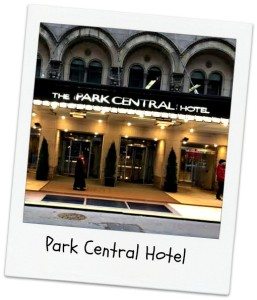
Perhaps the most intriguing mafia hits New York City, is the 1957 murder of Albert Anastasia, head of Murder Inc.
Umberto Anastasia arrived in America in 1917 and changed his name to Albert.
Anastasia became known as a ruthless and brutal criminal when he and his brother took control of the Brooklyn waterfront. Anastasia was known to have a very short temper that could quickly become violent.
At the age of 20, he became angry with a fellow longshoreman and strangled and stabbed him to death. Anastasia was dubbed the “Mad Hatter”.
With such a glowing reputation, Lucky Luciano brought Anastasia into the Morello family and used Anastasia to wrest control of the family from his boss Joe Masseria.
Anastasia was among the shooters who murdered Masseria at Luciano’s order in 1931.
Anastasia went on to become the boss of the Mangano family (later known as the Gambino family) from 1951 until 1957.
He was also one of the leaders of Murder Inc., created by the Commission to ensure that all Five Family members stayed in line.
If the Commission voted to take out a member of any of the Five Families, it was Anastasia who would ensure the hit was carried out.
Eventually, Anastasia wanted a more powerful role within the Five Families and a power struggle began between boss Vincent Mangano.
When Mangano disappeared without a trace, Anastasia was elevated to the head of the crime family and his underboss was a young Carlo Gambino.
The head of the Genovese family, Vito, was outraged that Anastasia, and not himself, was put in charge of the Mangano family.
Genovese plotted to get rid of Anastasia and was able to convince the heads of the other families that Anastasia had to go.
Anastasia was aware that his power – and his life - were in danger.
Here’s a newsreel clip of Anastasia keeping a low profile, presumably hiding from his enemies from the other families.
When he did come out of hiding, he went back to his regular daily routine including a morning shave at the barbershop at the Park Sheraton (now Central) hotel.
On October 25, 1957, in the middle of his shave, two men wearing fedoras, sunglasses, and overcoats, walked into the barbershop and fired a barrage of bullets at Anastasia who died in the barber chair.
Nobody was ever arrested for the murder of Albert Anastasia.
It was rumored for years that the “Crazy” Joey Gallo and his brother Larry since Joey Gallo referred to himself as a member of the “Barbershop Quintet."
The barbershop is now a Starbucks. When ordering your cappuccino don’t ask for an extra shot – of espresso, that is.
Albert Anastasia, before and after
(R) Joe Colombo Assassination
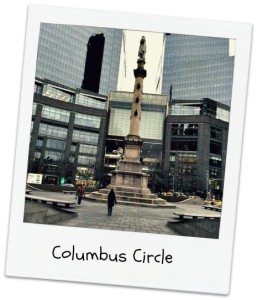
59th St. and Broadway
On June 28, 1971, Colombo family boss Joe Colombo was gunned down during the Italian-American Unity Day rally at Columbus Circle.
At the time a violent struggle for control of the Profaci-Colombo crime family was in full swing.
Although hundreds of people witnessed the shooting, no one was ever caught. Some say that “Crazy” Joey Gallo was behind the shooting.
A year after Columbo’s murder, ‘Crazy’ Joey Gallo was shot dead by Columbo family members at Umberto’s Clam House, the first stop on this tour.
And this brings us back full circle to the story of the mobsters of New York City.






